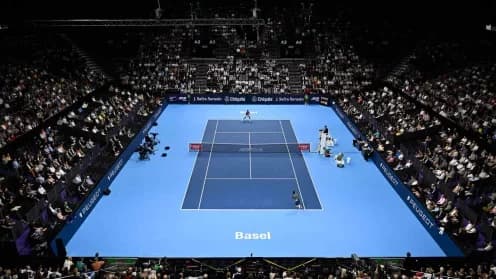As the ATP Tour navigates the complexities of player concerns, scheduling challenges, and the growing influence of Saudi Arabia, strong leadership is essential to uphold the integrity and future of professional tennis.
As the ATP Tour gears up for the 2024 season, it stands at a pivotal moment. The landscape has become increasingly intricate, encompassing player concerns, commercial interests, and shifting international dynamics. Under the leadership of Chairman Andrea Gaudenzi, a variety of pressing issues require attention. From the debate over ball variations to demanding tournament schedules, and the significant influence of Saudi Arabia in professional tennis, a host of critical topics await immediate consideration and strategic foresight. The challenge now lies in how the ATP will address these issues while preserving the sport's integrity.
A prominent issue that has garnered significant attention in the tennis community is the differing characteristics of balls used across various tournaments. Players, especially those at the top levels, have expressed their frustrations regarding the inconsistencies in ball performance, particularly when they switch between different surfaces and events. Although this might seem like a minor concern, it plays a substantial role in the player experience and can even affect match outcomes. Gaudenzi and his team will need to carefully evaluate whether these discrepancies in equipment can be standardized to ensure a more consistent playing environment, or if they must find a way to balance player preferences with the sponsorship and commercial agreements that keep the sport financially sustainable.
In addition to the discussion on ball variations, scheduling remains a critical issue. As more Masters 1000 tournaments adopt a two-week format, many players are discovering that the tour's schedule is becoming increasingly demanding. Striking a balance between maintaining a rigorous competition calendar and accommodating players’ needs for recovery is quite challenging. Leading athletes have expressed concerns regarding the physical strain of an extended season, especially when the most prestigious tournaments are often scheduled close together, allowing minimal time for recovery.
The ATP may need to reevaluate its existing calendar structure to prioritize the health and well-being of its players while also addressing the commercial needs of the sport. Nevertheless, one of the most urgent new developments in tennis is the increasing influence of Saudi Arabia, particularly through the nation’s Public Investment Fund (PIF) within the ATP. As an official sponsor, Saudi Arabia has already established a presence in the sport, but there is widespread speculation that the country’s financial power could pose a significant opportunity for a much larger involvement in tennis.
There are circulating rumors suggesting that the Public Investment Fund (PIF) may be interested in acquiring some of the esteemed Masters 1000 tournaments, including those held in Miami and Madrid. If these rumors hold any truth, it could represent a considerable change in both the geographic and financial aspects of the sport. Is it possible that Saudi Arabia could leverage its resources to relocate one or both of these events to its own territory, or even establish a new, high-profile tournament in the Middle East? This is a development that would profoundly impact the tennis calendar and potentially alter the dynamics of the ATP Tour for many years ahead.
In addition to this prospective acquisition, there is a broader issue regarding how the ATP Tour will develop its relationship with the WTA. The discussion surrounding a unified professional tour has persisted for many years, and with growing commercial interest and shifting fan expectations, it is a matter that warrants fresh examination. A potential collaboration or even a merger with the WTA could offer both practical and financial advantages, ranging from a more organized calendar to shared promotional opportunities. However, would such an initiative genuinely benefit the sport, or would it compromise the unique identity of the ATP Tour?
As we look forward, the upcoming months are crucial for the ATP. The choices made during this time could have significant consequences for the sport, influencing everything from the conditions players experience on the court to the economic dynamics that will determine the future of professional tennis. Given the intricate network of issues that need to be addressed, Gaudenzi and his team must exhibit decisive leadership, insight, and a steadfast dedication to the long-term prosperity of the sport. With the 2024 season approaching rapidly, the future of men's tennis is at a critical juncture, and the manner in which these challenges are confronted will shape the trajectory of the ATP Tour for many years ahead.
As the ATP Tour gears up for the 2024 season, it stands at a pivotal moment. The landscape has become increasingly intricate, encompassing player concerns, commercial interests, and shifting international dynamics. Under the leadership of Chairman Andrea Gaudenzi, a variety of pressing issues require attention. From the debate over ball variations to demanding tournament schedules, and the significant influence of Saudi Arabia in professional tennis, a host of critical topics await immediate consideration and strategic foresight. The challenge now lies in how the ATP will address these issues while preserving the sport's integrity.
A prominent issue that has garnered significant attention in the tennis community is the differing characteristics of balls used across various tournaments. Players, especially those at the top levels, have expressed their frustrations regarding the inconsistencies in ball performance, particularly when they switch between different surfaces and events. Although this might seem like a minor concern, it plays a substantial role in the player experience and can even affect match outcomes. Gaudenzi and his team will need to carefully evaluate whether these discrepancies in equipment can be standardized to ensure a more consistent playing environment, or if they must find a way to balance player preferences with the sponsorship and commercial agreements that keep the sport financially sustainable.
In addition to the discussion on ball variations, scheduling remains a critical issue. As more Masters 1000 tournaments adopt a two-week format, many players are discovering that the tour's schedule is becoming increasingly demanding. Striking a balance between maintaining a rigorous competition calendar and accommodating players’ needs for recovery is quite challenging. Leading athletes have expressed concerns regarding the physical strain of an extended season, especially when the most prestigious tournaments are often scheduled close together, allowing minimal time for recovery.
The ATP may need to reevaluate its existing calendar structure to prioritize the health and well-being of its players while also addressing the commercial needs of the sport. Nevertheless, one of the most urgent new developments in tennis is the increasing influence of Saudi Arabia, particularly through the nation’s Public Investment Fund (PIF) within the ATP. As an official sponsor, Saudi Arabia has already established a presence in the sport, but there is widespread speculation that the country’s financial power could pose a significant opportunity for a much larger involvement in tennis.
There are circulating rumors suggesting that the Public Investment Fund (PIF) may be interested in acquiring some of the esteemed Masters 1000 tournaments, including those held in Miami and Madrid. If these rumors hold any truth, it could represent a considerable change in both the geographic and financial aspects of the sport. Is it possible that Saudi Arabia could leverage its resources to relocate one or both of these events to its own territory, or even establish a new, high-profile tournament in the Middle East? This is a development that would profoundly impact the tennis calendar and potentially alter the dynamics of the ATP Tour for many years ahead.
In addition to this prospective acquisition, there is a broader issue regarding how the ATP Tour will develop its relationship with the WTA. The discussion surrounding a unified professional tour has persisted for many years, and with growing commercial interest and shifting fan expectations, it is a matter that warrants fresh examination. A potential collaboration or even a merger with the WTA could offer both practical and financial advantages, ranging from a more organized calendar to shared promotional opportunities. However, would such an initiative genuinely benefit the sport, or would it compromise the unique identity of the ATP Tour?
As we look forward, the upcoming months are crucial for the ATP. The choices made during this time could have significant consequences for the sport, influencing everything from the conditions players experience on the court to the economic dynamics that will determine the future of professional tennis. Given the intricate network of issues that need to be addressed, Gaudenzi and his team must exhibit decisive leadership, insight, and a steadfast dedication to the long-term prosperity of the sport. With the 2024 season approaching rapidly, the future of men's tennis is at a critical juncture, and the manner in which these challenges are confronted will shape the trajectory of the ATP Tour for many years ahead.







